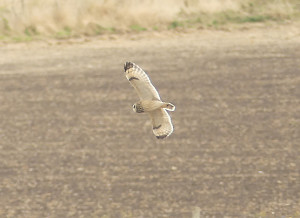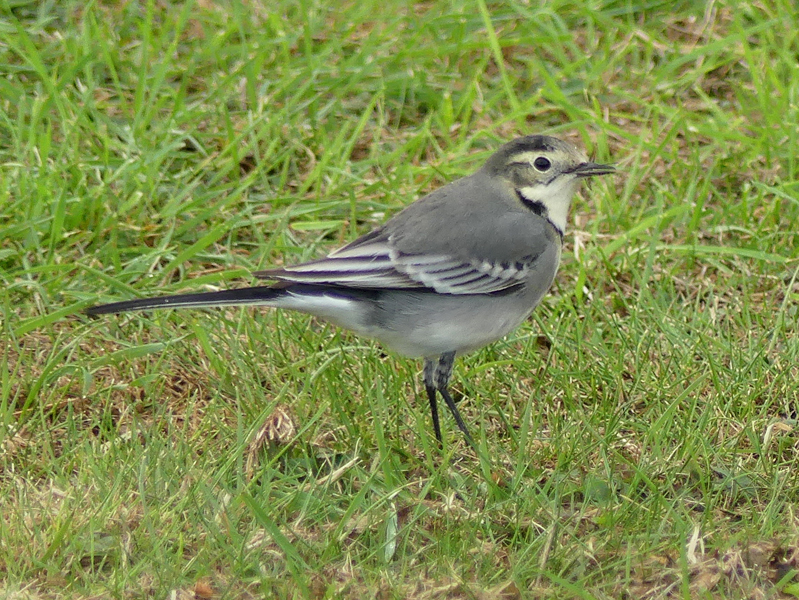
One thing about birding which does not sit well with me is getting up early. Although I am used to it because of leading tours, when I have free time I do not often get up very early but today was an exception as I wanted to get to the Isle of Sheppey in the early morning to give myself time to look for whichever interesting migrants that might be around.
On arrival at Leysdown I drove straight past the coastal park, planning to return later to look for migrants, and took an early morning look over the stubble fields to search for the reported Common Crane. Large groups of Greylag Geese contained some obviously smaller birds which turned out to be 14 Greater White-fronted Geese, a nice start to the day. However, for the second time in a week there was no sign of the Crane despite being told it had been seen shortly before my arrival! Well, never mind, looking for it would give me a good reason to have a good walk around to look for other interesting species.
Having stopped the car I took a look around some coastal vegetation and wooden huts but only came up with a couple of Goldcrests, a Robin, a couple of Reed Buntings and a Woodpigeon but on the mudflats nearby were huge numbers of Oystercatchers feeding along with smaller numbers of Curlew, a large flock of Black-tailed Godwits, 1 Bar-tailed Godwit and 3 Red Knot. A decent collection of species for a 15 minute walk and the view of a nice rainbow over the beach was wonderful.
Anyone who has seen my blogs, tweets or facebook postings over the last couple of months will have noticed that I like Ostercatchers. These amusing characters are especially numerous on the South East coast of the Isle of Sheppey and it is fun to watch them go about their business, squabbling over the shellfish they capture.
 Oystercatcher by Nick Upton
Oystercatcher by Nick Upton
I continued my search for the Crane by walking along the flood defences which border an area of saltings, stubble fields and eventually end up alongside the Swale National Nature Reserve. Large numbers of Lapwing, 300+ Golden Plover, many Grey Herons, Kestrels, 2 Common Buzzards and 4 Western Marsh Harriers, one of which mounted an attack on a female/juvenile Hen Harrier, presumably trying to rob it of prey, but still no Crane!
Passerines included many Reed Buntings, 5 Stonechats having an argument, 2 Cetti’s Warblers, 2 Bearded Tits and some number of Goldcrests feeding in low vegetation alongside a ditch, all of which were nice but when an alert on Birdguides.com came through with news of Common Crane at Swale NNR I was bewildered. How could I miss such a large bird that is obviously right in front of me? Repeated scanning gave me a brief view of a large bird in flight that looked like it could be a Crane in the far distance, so I decided to find myself a vantage point to check the area I saw it in.
 Stonechat by Nick Upton
Stonechat by Nick Upton
So after some lunch I walked to the rear of the pitch and putt course at Leysdown where I thought I could get a good view across the farmland where the Crane might be. As I walked through some rough grassland I scared up a roosting Short-eared Owl; what a view!
 Short-eared Owl by Nick Upton
Short-eared Owl by Nick Upton
Checking the bushes for migrant birds did not turn up much, just 1 Song Thrush, 3 Blackbirds, 2 Goldcrests but more than a dozen Robins but scanning the distant fields from my elevated spot finally provided me with my Common Crane, somewhat distant but quite obvious nonetheless. Elsewhere in the country there were lots of much rarer birds that I guess many birders will be chasing but most of them are birds which are common where I live in Thailand and do not mean much to me, whereas Common Crane to me is an exciting bird due to its size and elegance, in fact this bird was not even a year tick for me although the first time I have seen it in Kent.
Walking around some more vegetation turned up a few more interesting birds – large numbers of Meadow Pipit, a flock of 5 Long-tailed Tits, 2 Redwings hiding in a berry tree, several more Goldcrests, lots more Robins and a very unusual sight of a pair of Bearded Tits feeding in poplar and hawthorn trees!
This had been a nice morning and early afternoon of birding with some good species while a couple of Pied Wagtails posed very close to my car as I was leaving.
 Pied Wagtail by Nick Upton
Pied Wagtail by Nick Upton


 October 9th, 2016
October 9th, 2016  Nick
Nick 
 Posted in
Posted in  Tags:
Tags: 









